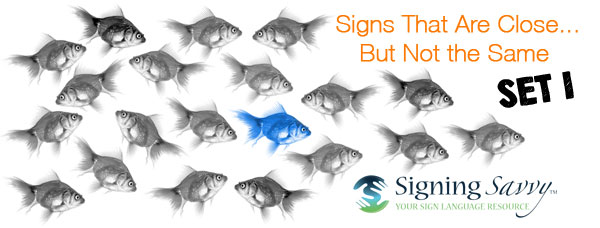
Signs That Are Close... But Not the Same - Set 1
This article is part of our “Signs That Are Close... But Not the Same” series, which highlights signs that look similar, but have different meanings.
The ASL signs shown below look similar, but are not the same. There are many ASL signs that when produced look similar, but in fact have a completely different meaning. Below you will find examples of such signs. Watch closely to see if you can see the differences. In addition, watch my eyebrows, look to see when I tilt my head or lean my body in a certain way, even what my mouth is doing. These nuances are called inflections and trust me, inflections matter.
1. Sick vs. Disease
You can remember the signs for SICK and DISEASE because your extended middle fingers point at the areas where we often feel sick - at your forehead and stomach. For SICK, touch your forehead and stomach at the same time. DISEASE is similar, but you make small circles in and out from the body.
 |
2. Ask vs. Question
The signs for ASK and QUESTION can look similar, but for ASK you make a bent motion with your index finger as it moves in the direction of who you are asking the question of, while when you sign QUESTION you make the outline of a question mark in the air.
 |
3. Senate vs. Committee
SENATE and COMMITTEE look similar because they are both ASL initialized signs of the sign for MEMBER. The S-hand is used when signing SENATE and the C-hand is used when signing COMMITTEE.
 |
4. Science vs. Experiment
To remember these signs, think of combining the contents of two beakers or test tubes by pouring them into a single container. SCIENCE uses A-hands and EXPERIMENT is an ASL initialized sign of SCIENCE that uses E-hands. CHEMISTRY (C-hands) and BIOLOGY (B-hands) are also ASL initialized signs of SCIENCE.
 |
5. Convince me vs. Convince you
Convince is a directional sign. To sign CONVINCE ME, your B-hands make a chopping motion at the same time towards your neck and to sign CONVINCE YOU the motion is done outward, towards the person you are trying to convince.
 |
6. Pray vs. Request
PRAY and REQUEST are similar, but for PRAY your hands are together and make a downward motion in front of your chest, while REQUEST starts with your hands away from your body and then they move in to come together and make the PRAY sign.
 |
7. Attention vs. Focus
ATTENTION has both open flat hands start by the eyes and make small forward movements, while your hands when signing FOCUS move forward and down as they focus in on a point.
 |
8. Russia vs. Brag
RUSSIA and BRAG are both signed at the waist, but RUSSIA uses 5-hands (think of placing the hands at the waist during a Russian dance), while BRAG alternates Y-hands (think of strutting around).
 |
9. Drink (as in "drink something non-alcoholic") vs. Drink (as in "drink liquor")
It’s easy to get the different signs for DRINK confused, but signing you need a drink can have two very different meanings depending on what sign you use. The two signs use the same movement and placement, but DRINK (as in "drink something non-alcoholic") uses a C-hand, while DRINK (as in "drink liquor") uses a modified C-hand with three fingers.
 |
10. Don't mind vs. Don't care
DON’T MIND and DON’T CARE both start at the nose and move away from the face, but DON’T MIND uses the index finger, while DON’T CARE starts as a flat O-hand and opens up.
 |
11. Glasses vs. Gallaudet
This example shows that small differences in movement matter. For both signs, the G-hand starts open and closes as it pulls back - there is one movement for GALLAUDET and two movements for GLASSES. You can remember that the sign for GALLAUDET is like the sign for GLASSES because Thomas Gallaudet wore glasses.
 |
12. Empty vs. Available
This is another example of how small differences in movement matter. For both signs the middle finger slides out along the back of the non-dominant hand - there is one movement for EMPTY and two movements for AVAILABLE.
 |
13. Sad vs. Friendly
Facial expressions are important when conveying meaning in sign language, but especially when it comes to signing emotions. When signing SAD, the open 5 hands slowly slide down the face, while for FRIENDLY they make a fluttering motion while moving up and away from the face.
 |
14. March vs. Funeral
A similar movement is made when signing MARCH and FUNERAL, but MARCH uses 4-hands with the palms down marching out (think of your fingers as two rows of (four) band members marching together in sync in a parade), while FUNERAL uses upright V-hands (remember your fingers point up by thinking of them as the legs of cartoon characters - they always die with their legs/feet sticking up in the air).
 |
How can I figure out the difference between signs on my own?
If you see two signs that look close, but not the same, and you’re not sure, you may use Signing Savvy features to help you figure out the difference. All of our signs have sign descriptions and memory aids that members may access. Reading the sign description and memory aids for the signs will help you figure out the small differences between them that your eyes don’t catch at first. We also recommend using the pause and slow motion feature to slow down the video, so you may take a closer look. These features are available to Signing Savvy members.
Take a look, it's in a book!
These examples are aligned with the Visual Discrimination section of Lesson 8 (page 98) from Lessons and Activities in American Sign Language by Brenda E. Cartwright and Suellen J. Bahleda. Check out the book for more ASL Activities and watch for more examples from this series: “Signs That Are Close... But Not the Same.”
Resources
Signing Savvy is a participant in the Amazon Services LLC Associates Program, an affiliate advertising program designed to provide a means for sites to earn advertising fees by advertising and linking signingsavvy.com to Amazon properties. That means Signing Savvy may contain affiliate links. If you make a purchase after clicking on an affiliate link, your cost will be exactly the same regardless, but Signing Savvy will automatically receive a small commission. Your support is greatly appreciated and helps us continue to improve Signing Savvy!
ADVERTISEMENTS
 Brenda Cartwright is a Coda, seasoned interpreter, a master teacher, well known presenter, and author of several best selling sign language and interpreting textbooks from the RID Press. For 35 years Brenda was the Chair of the Sign Language Interpreter Program at Lansing Community College in Lansing, Michigan.
Brenda Cartwright is a Coda, seasoned interpreter, a master teacher, well known presenter, and author of several best selling sign language and interpreting textbooks from the RID Press. For 35 years Brenda was the Chair of the Sign Language Interpreter Program at Lansing Community College in Lansing, Michigan.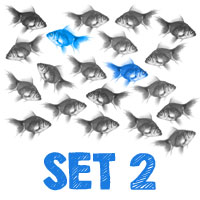 Signs That Are Close... But Not the Same - Set 2
Signs That Are Close... But Not the Same - Set 2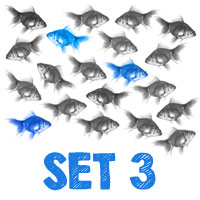 Signs That Are Close... But Not the Same - Set 3
Signs That Are Close... But Not the Same - Set 3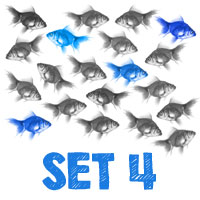 Signs That Are Close... But Not the Same - Set 4
Signs That Are Close... But Not the Same - Set 4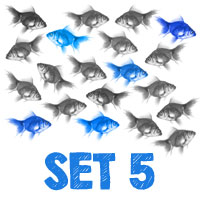 Signs That Are Close... But Not the Same - Set 5
Signs That Are Close... But Not the Same - Set 5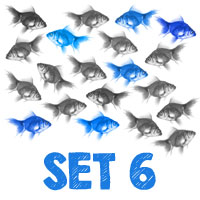 Signs That Are Close... But Not the Same - Set 6
Signs That Are Close... But Not the Same - Set 6








Savvy User EllenTuesday, May 24, 2016
I remember, way back in the day, having a hard time remembering the difference between funeral and march/parade.
Then someone said to easily remember funeral - think of the cartoon characters - they always die with legs/feet sticking up in the air.
No problems since then.